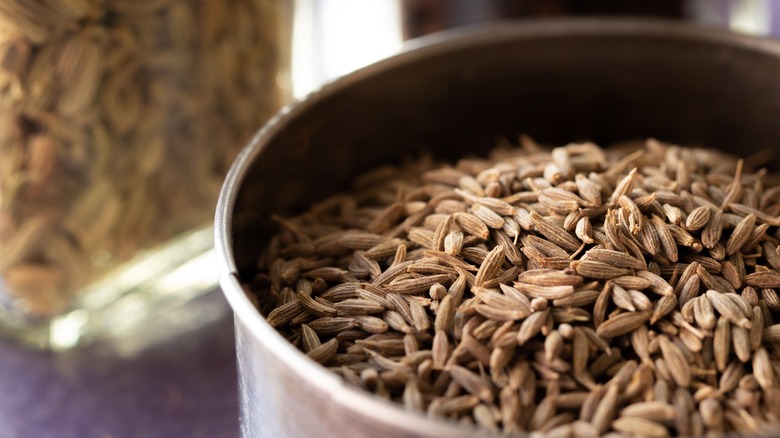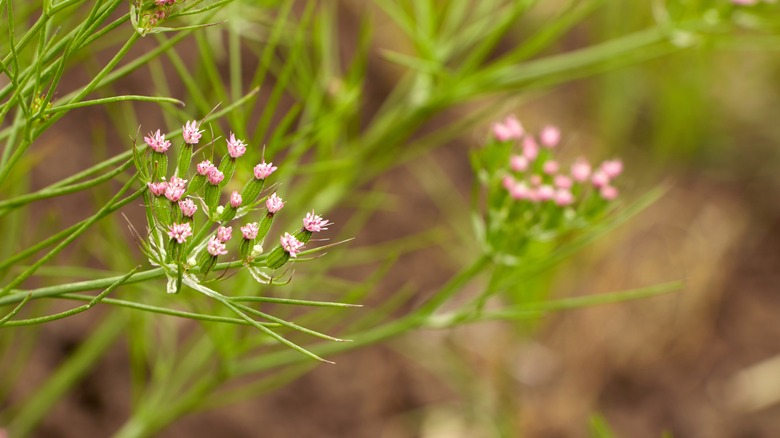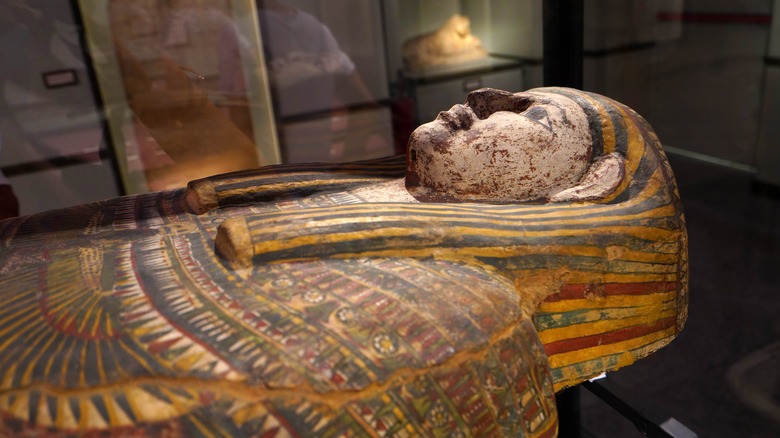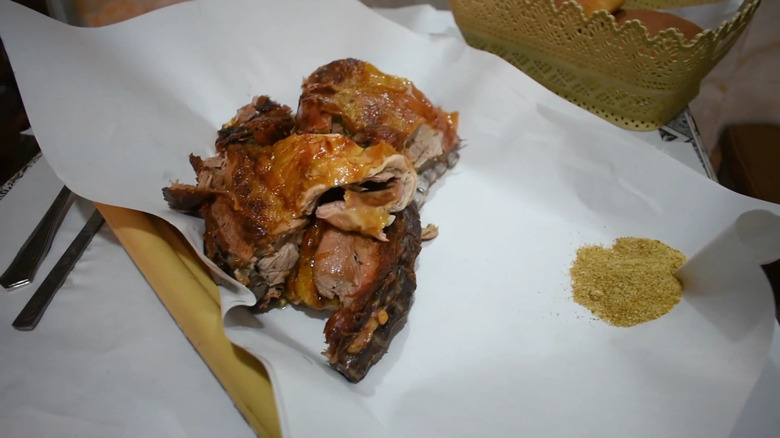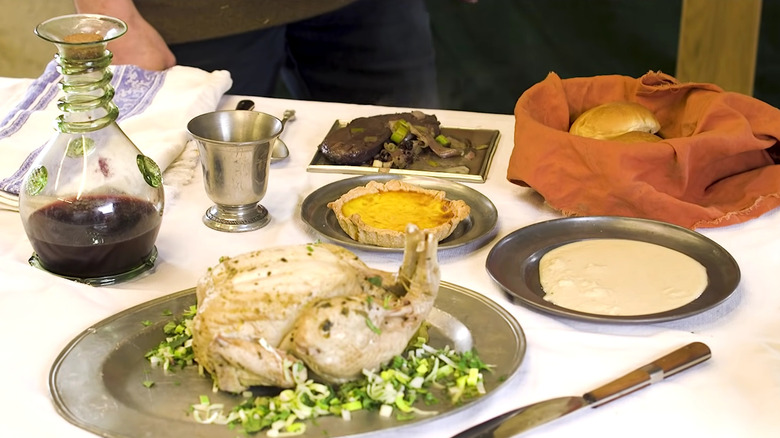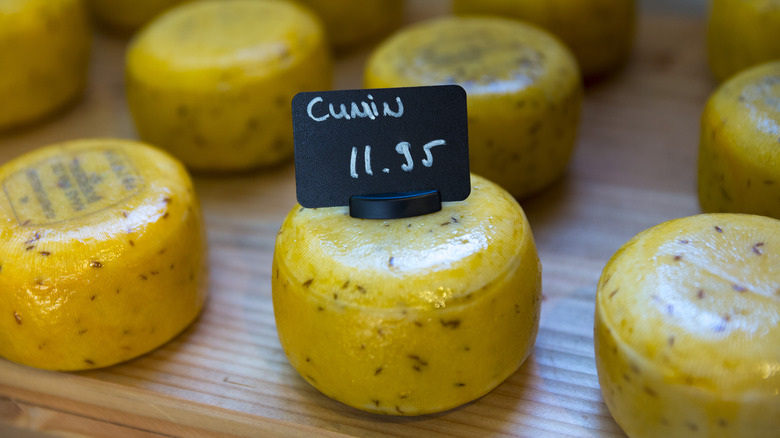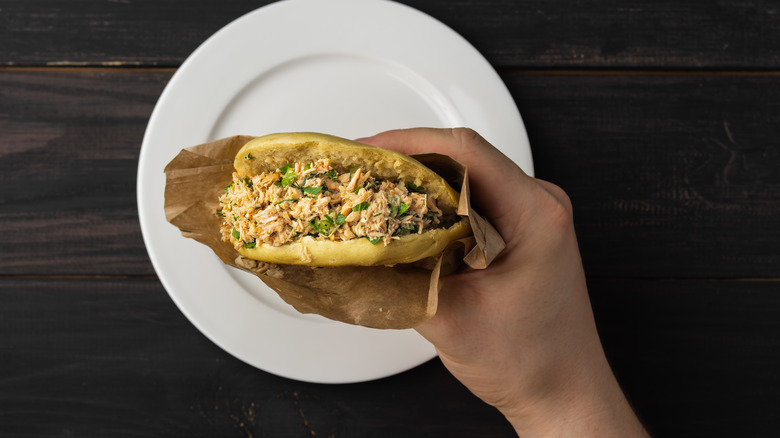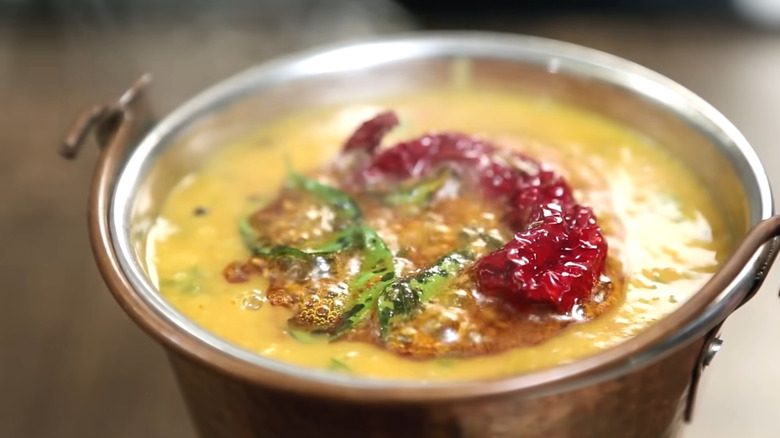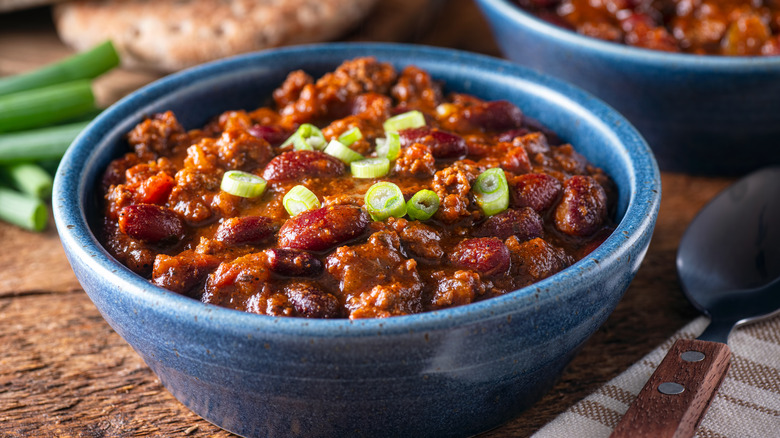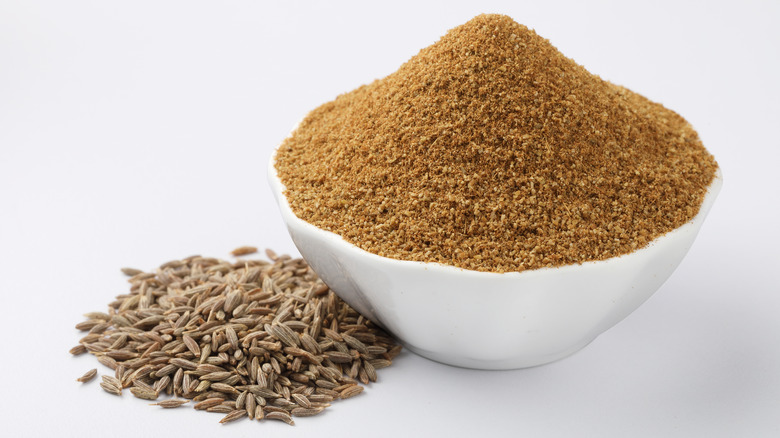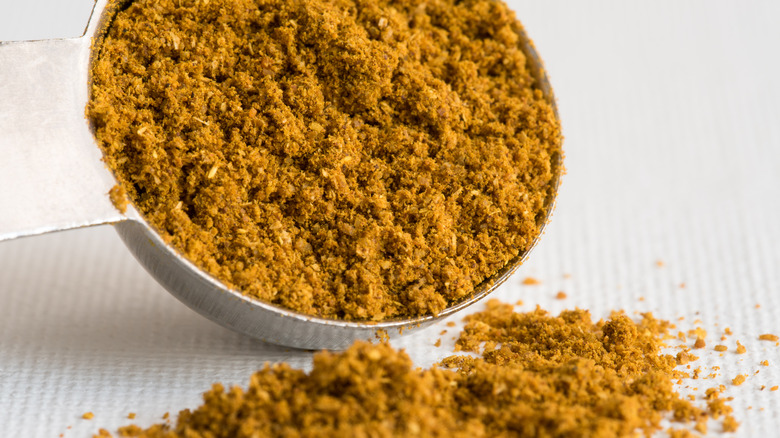The Truly Ancient Origins Of Cumin
Cumin, a member of the parsley family, is a pillar of seasoning in a variety of foods and cultures — in fact, it's the second most popular spice in the world. The spice itself can be used whole, in the form of cumin seeds, or ground. Interestingly, the term "cumin seeds" is a misnomer; the dried spice is actually the plant's fruit. When consumed either ground or whole, cumin is aromatic and flavorful, and carries impressive antibacterial properties (via Healthline). These characteristics have seen it prized by humans for millennia.
It is postulated that humans first began to harvest and consume cumin in the Levant, thousands of years ago. While it is not known exactly when and where cumin was first cultivated, the plant is now grown and consumed globally. The enduring popularity of the spice has a lot to do with its suitability to a variety of cuisines as can be seen through its use in ancient cultures as well as those around the world today. So, while black pepper might be the world's most popular spice, cumin remains one of both ancient origin and immense contemporary importance.
The earliest cumin seeds have been dated at 8,000 years old
One of the earliest known samples of cumin comes from a submerged Neolithic settlement, known as Atlit-Yam, located off the coast of Israel. Here, seeds from wild cumin plants that are thought to be 8,000 years old have been recovered, as per the Journal of Archaeological Science. Although the seed's proximity to the settlement infers their use by the Neolithic community, this cannot be confirmed. Other ancient samples of cumin have also been collected across the Mediterranean basin, including from Ancient Egyptian pyramids.
One explanation for the spread of wild, and then subsequently domesticated, cumin around the basin is the migration and movement of people, most notably the Philistines. A study published in Scientific Reports claims that these seafaring people were responsible for the migration of multiple plants during The Bronze Age, including cumin. This not only affected the populations living throughout the Mediterranean basin at the time but also had numerous knock-on effects that are still being expressed by the area's cultures — as well as its flora and fauna — today.
Cumin was prized for its medicinal properties
The Ancient Egyptians boasted a thorough and impressive range of medicinal practices that were incredibly advanced for the time. A study published in the Saudi Journal of Biological Sciences even names Egypt as the birthplace of modern medicine, with healers having specialities much like today's doctors. Of course, ancient Egyptians did not have access to modern pharmaceuticals. Instead, they used a range of plants, herbs, and spices — one of which was cumin — to treat ailments.
As summarized by the same study, cumin had a variety of medicinal uses in Ancient Egypt, including as a treatment for dental issues, a remedy to reduce flatulence, and as part of the enema process. Ancient ayurvedic medicine, which comes from India, also prizes cumin. Here the plant is linked to alleviating pretty much any gastrointestinal issues ranging from bloating all the way up to dysentery, as per the Journal of Food Science Technology. The spice has even been touted as a means of alleviating menstrual cramps and morning sickness as well as a way of boosting a mother's breast milk production (via Professor's House).
Cumin has long been associated with death rituals
Outside of medicine, the most notable use of cumin in Ancient Egypt was as part of the embalming process. Mummifying bodies, and thus preserving them in a form close to their living shape, had immense spiritual importance in Ancient Egypt. In order to ensure a well-preserved mummy, the Egyptians had to completely dry the corpse as well as protect it from bacteria. Cumin, thanks to its antibacterial properties, was one of many spices used to clean and preserve the mummified bodies.
Outside of Egypt, the association between cumin and death rituals remains. In Greece, a dessert known as kolyva is often served after funerals. Cumin, as well as a host of other spices, are included in this dish to celebrate the life lived by the deceased.
Somewhat more gruesomely, cumin seeds were often used in Britain after an execution had taken place. If charged with heinous crimes such as high treason the executed traitors' body parts were often parboiled before being put on public display. Cumin seeds were often added to the boiling pot to preserve the body parts, thus ensuring the display lasted for longer.
Moroccan cuisine still prizes cumin
Morocco is one of the many countries that continue to utilize cumin heavily. Of course, the country is no stranger to spice. Cookbook author Jeff Koehler describes how a range of them are commonly used in Moroccan cuisine: "For spices cinnamon is very typical, making an interesting mixture with the savory flavors; cumin; sweet paprika — usually not spicy, some dishes have a spicy paprika, but often a little bit of sweet paprika; and freshly ground black pepper. Other things have very specific ingredients, but those are the main ones," (via The Splendid Table).
So prevalent is cumin in Moroccan food that the spice is often kept on tables in little dishes to be sprinkled at will, much like how pepper is treated in other countries. Perhaps the most famous Moroccan dish that utilizes cumin is mechoui — roasted sheep or lamb. This long-roasted, succulent meat is dressed only with salt and cumin, both of which amplify the meat's already brilliant flavor.
The spice was very popular in medieval Europe
Heavily spiced food was all the rage in medieval Europe. As with most trends, eating richly spiced food was a means of indicating wealth, status, and power — a result of the scarcity and subsequent cost of spices in Europe during this era. For those that had the means, cumin was often used alongside other spices, like cinnamon, to spice an array of food including meat. As access to spices steadily improved and costs dropped, cumin became so popular that it was even accepted as a means of paying rent in England. This was a common practice from around 800 A.D. to 1200 A.D.
Somewhat unsurprisingly, the abundance and availability of spices like cumin — which came with the process of colonization — saw the upper classes move away from heavily spiced foods. Instead, these wealthy individuals sought refinement, as associate professor of food studies Krishnendu Ray highlighted to NPR: "The elite recoiled from the increasing popularity of spices. They moved on to an aesthetic theory of taste. Rather than infusing food with spice, they said things should taste like themselves. Meat should taste like meat, and anything you add only serves to intensify the existing flavors." After this time, cumin use faltered in Britain. However, the more recent acceptance of global cuisines has seen its popularity increase again.
Cumin is used to make many traditional Dutch cheeses
It was not just Great Britain that became spice-rich through colonization. The Netherlands also gained immense wealth through the exploitation and colonization of spice-producing countries. This is most readily typified by the nation's infamous Dutch East India Company, which made a fortune from both Asian and African countries. Aside from wealth, the Dutch East India Company also brought new products to citizens back home, one of these being cumin.
The sudden abundance of cumin led to the spice's inclusion in many food products of this time. Among these is Leyden, a classic Dutch cheese. Made from cow's milk, this cheese has long been flavored with cumin. Another Dutch cheese that rose to prominence during the colonial period was an iteration of Gouda that was also flavored with cumin. Still popular, this creamy cheese is packed full of cumin seeds, which lend a burst of flavor to every mouthful.
The spice is widely used throughout China
The Western experience of Chinese food is often limited to only a few of the country's many cuisines — hence why some people are surprised to learn that cumin plays a vital role in China's culinary landscape. The spice appears in a range of dishes from Xinjiang's kachuan to Shaanxi's rou jia mo. As a prevalent ingredient, local cumin varieties have become married to several cooking techniques popular in China, including stir-frying. Shuai Yang, a chef based in San Francisco explains how this cooking process affects the flavor of the spice: "This cumin has more of a pop and aroma when you stir-fry it. It's almost more floral compared to American or Mexican cumin," (via San Francisco Chronicle).
Cumin use in China is heavily associated with the Uyghurs, a population that makes up nearly half of Xinjiang's population of 25 million. Long discriminated against, the Uyghurs' treatment in China has worsened rapidly — including a possible genocide perpetrated by the Chinese government. Yet, Uyghur food is still found across China, even in Beijing. Further examples of the delicious, cumin-laced cuisine can also be found in London and New York City.
Trade and colonization has seen cumin span the globe
From the earliest days of its usage, cumin has been transported around the world. Initially, it was restricted to Western Asia and the Mediterranean basin, where the spice was predominantly distributed by the Philistines. A few centuries later, the Ancient Romans brought it along with them as they began to conquer vast swathes of Europe. While both of these powers undoubtedly contributed to cumin's current popularity, it was the Imperial Spanish that had the greatest impact of all.
It was the Spanish that brought cumin to South America, where it grew readily in the warm climate. Today, the spice is a common feature in many South, Central, and North American cultures. Among these is Mexico, where cumin features in some iconic dishes, as restaurateur Margarita Carrillo highlights: "Across Mexico the use of cumin is quite common for moles, pipianes, adobos, and other sauces [with nuts and seeds], such as almendrados, encacahuatados, and nogadas. But always in small quantities that don't dominate the final flavor of the dish," (via Aramco World).
Cumin is vitally important to Indian cuisine
During the 2022 fiscal year India produced over 700,000 metric tons of cumin (via Statista). To put this into perspective, the next biggest producer, Syria, only reaches a total of around 25,000 metric tons per year (as per Royal Spices). As the largest producer, it should come as no surprise that cumin features prominently in Indian cuisine. Here cumin is used not only as a flavoring but also as a vital part of certain Indian cooking processes, including tadka. This is the process of infusing hot oil with spices before pouring over a finished dish, such as dal. Thisadds both flavor and texture.
For chefs that seek to combine their love for Indian cooking with traditional ayurvedic medicine, spices like cumin are a blessing. Ayurvedic chef Raul Garcia Crespo highlights why: "I love ginger, turmeric, and cumin, and use them almost every day. Ginger helps with digestion, sickness, and keeps your body warm during winter. Turmeric is great for its anti-inflammatory properties, purifying blood and reducing gas. It's also good for the liver and acts as an antiseptic. When I cut myself in the kitchen, I wash the cut with water and apply turmeric to stop the bleeding. Lastly, nothing helps the digestive system more than cumin," (via National Geographic).
Cumin is the cornerstone of newer cuisines like Tex-Mex
While cumin has nestled into many of the world's existing cuisines, the spice has also been used to help shape newer cuisines. The most prominent example is Tex-Mex. Arising during the late 19th century, Tex-Mex has become an established cuisine in its own right despite detractors labeling it as "fake Mexican food." In reality, Tex-Mex has many unique characteristics including the ubiquitous and heavy use of cumin.
The frequency of cumin use in Tex-Mex, as seen through its inclusion in classics of the cuisine like chili con carne, is not mirrored in Mexico itself. Here, the spice is more of a contested topic as Mexican chef Roberto Santibañez explains: "Some states have more pronounced cumin, some states don't use cumin at all ... What you see today, like me or like many others such as urban Mexican people with more of a pan-Mexican vision of our foods, we are starting to say, 'Okay, how much cumin goes into a salsa verde?' Some people will tell you, 'Oh, no, no, no, no, we don't put cumin in salsa verde at all,'" (via The Splendid Table).
Such difference in cumin usage is largely attributable to the "Chili Queens", a group of women from The Canary Islands that started Tex-Mex cuisine by selling world-class chili in their new home of San Antonio. One of the spices they used to flavor their famous dish was, you guessed it, cumin.
Adulterated cumin is becoming increasingly common
It has been widely reported that up to 80% of olive oil on the market is fake. In 2013, Britain was wracked by the so-called horse meat scandal, when it was discovered that products labeled as beef actually contained equine meat. In other words, the adulteration of food products is nothing new. Unfortunately, cumin has also gained a reputation as a product that is often laced with other ingredients.
Often, the substances added to the cumin included both grass and stone dust. These are used to bulk out the product, giving the sellers a greater profit margin. However, traces of shells from both peanuts and almonds have also been used to achieve a similar effect — which could make the adulterated spice life-threatening for those who suffer from allergies.
While some have suggested contamination arises as a mistake, other people are more skeptical. Chris Elliott, a professor of food safety and microbiology, is of the latter camp. He explained to The Independent: "Whenever there's a crop failure you always have to look to see what is the potential fraud that is behind that. This time the crop failure is cumin and it does seem to be that there has been fraud going on."
It forms an integral part of the world's spice blends
While cumin itself is a common addition to many recipes, the spice also ends up in a lot of dishes thanks to it playing a part in many of the world's famous spice blends. First and foremost amongst these is garam masala. In India, this spice blend is such a common feature of the country's cuisine that many have deemed it an integral facet of Indian food.
In Morocco, the most celebrated spice blend is ras el hanout, a complex blend that can vary widely in flavor. While many ingredients may change from blend to blend, all versions of ras el hanout impart a warm flavor which is largely thanks to the prevalence of cumin.
Cumin also features in some of the world's most beloved condiments. This includes the Yemeni zhoug, a hot sauce with notable freshness and zing. Naturally, cumin is deemed an essential ingredient in zhoug, confirming that cumin is one of the most versatile and important spices in global cuisine.
